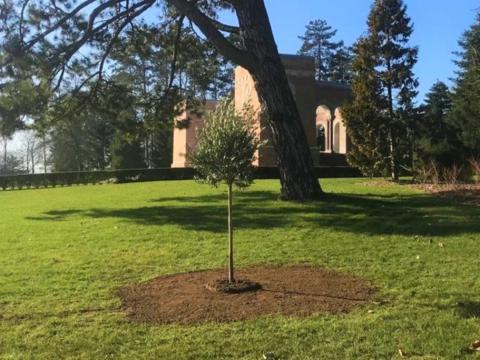As the American Battle Monuments Commission (ABMC) marked its 100th anniversary on March 4, many of its cemeteries welcomed a new addition to their landscapes as a nod to the historic occasion. At 25 of the 26 ABMC cemeteries overseas, an Olea europaea or olive tree is being planted as part of the agency’s year-long centennial commemoration.
“The Olea is a symbol of peace and friendship, which is fitting at our cemeteries and in recognition of the relationship we share with our host nations,” said ABMC’s Director of Horticulture Doug Meney, who oversaw the project. “But it is also a horticulturally appropriate choice given the varied climates at our sites around the world.”
Other species were considered for the honor as well, including the Laurus nobilis or bay laurel tree, known in the culinary world for its aromatic leaves and as a symbol of wisdom, courage and strength. However, the tree can be susceptible to disease and winter cold, has a fast growth rate and a dense canopy. Ultimately, the Olea, the branch of which is featured on the seal of the U.S. seal, emerged as the top choice.
The only cemetery that has planted a different species is the Corozal American Cemetery located in Panama. According to Meney, the local horticultural staff at the site had not previously seen the Olea tree growing in the country, which is known for a particularly long and heavy rainy season from May to November. Instead, the Corozal American Cemetery staff chose the Roble primavera Guayacan or Guayacan trumpet tree, a bright and beautiful flowering species native to Central and South America.
The layout of ABMC cemeteries from both an architectural and horticultural design perspective were meticulously outlined, including the types of plants and trees to be planted. While the Olea trees were not specifically incorporated into the design, they still fit within the overall plan descriptions, Meney said.
“In a lot of our wooded areas these zones are described as being planted with a ‘mix of broadleaved and coniferous trees,’” said Meney. “We have encouraged the trees to be planted in these areas or close to their edges.”
Each planting site will eventually bear a plaque noting the trees’ significance, which will note that they were planted to mark the centennial year of the ABMC. Furthermore, the plaque will acknowledge that the trees symbolize “over a century of dedicated service by the gardeners, masons, mechanics, guides, associates, and superintendents of ABMC who have always taken care of our sacred sites and have continuously preserved the memory of our fallen heroes.” Time capsules may be incorporated as well before the end of this year.
Meney and ABMC’s horticultural staff have worked to find the hardiest varieties of the trees available for the agency’s sites in northern Europe, and have sought out local supplier recommendations in other locations to ensure the best possible health of the plants. Some varieties of the Olea have been known to live to be thousands of years old.
“When we ask how long Olea trees can live, it’s like asking how long is a piece of string,” said Meney. “But our green teams work incredibly hard to care for all the species planted at our sites and these will be well-tended, treasured parts of our landscapes for years to come.
“We want them to be matured, beautiful and healthy even as ABMC marks the bicentennial in another 100 years,” he added.
ABMC is hosting numerous events throughout the year both in the U.S. and at its 26 cemeteries across the world to commemorate this historic milestone.
Created in 1923, ABMC’s mission remains the same after a century of duty: to honor the service, achievements, and sacrifices of America’s armed forces by serving as the guardian of our nation’s overseas cemeteries, memorials and monuments, and by preserving their legacy for future generations.

 An official website of the United States government. Here's how you know.
An official website of the United States government. Here's how you know. 